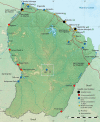Outbreak of Oropouche Virus in French Guiana
- PMID: 34545800
- PMCID: PMC8462337
- DOI: 10.3201/eid2710.204760
Outbreak of Oropouche Virus in French Guiana
Abstract
Oropouche fever is a zoonotic dengue-like syndrome caused by Oropouche virus. In August-September 2020, dengue-like syndrome developed in 41 patients in a remote rainforest village in French Guiana. By PCR or microneutralization, 23 (82.1%) of 28 tested patients were positive for Oropouche virus, documenting its emergence in French Guiana.
Keywords: Bunyaviridae; French Guiana; Latin America; Oropouche fever; Oropouche virus; Oropoucheorthobunyavirus; arboviruses; dengue-like syndrome; emergent disease; outbreak; vector-borne infections; viruses.
Figures


References
-
- Naveca FG, Nascimento VAD, Souza VC, Nunes BTD, Rodrigues DSG, Vasconcelos PFDC. Multiplexed reverse transcription real-time polymerase chain reaction for simultaneous detection of Mayaro, Oropouche, and Oropouche-like viruses. Mem Inst Oswaldo Cruz. 2017;112:510–3. 10.1590/0074-02760160062 - DOI - PMC - PubMed
MeSH terms
Supplementary concepts
LinkOut - more resources
Full Text Sources

